One of the most endearing aspects of the art of Karel Zeman is his use of music in the soundtracks prepared for his films. There is a lovely music score composed by Zdenek Liska in "Baron Prasil" with Frantisek Belfin conducting the Filmovy Symfonicky Orchestra. This music adds layers of charm and mystique to the action on the screen, blending a sense of orchestral enchantment to the artistic merits of the story. In one of the film's most evocative scenes, Baron Munchausen calls himself a "Fantast," a visionary or dreamer. Perhaps this is also a tale of the artist who brings forth imaginary worlds and invites an audience to willingly embark upon a similarly fantastic journey.
|
There are some very evocative scenes in "Baron Prasil" by Czech director/ filmmaker Karel Zeman (1910-1989). In the United States this film was released as "The Fabulous Adventures of Baron Munchausen." Live action is combined with animation in a wonderfully inventive and charming manner. We travel to the Moon in order to meet the Baron (Milos Kopecky) as well as Cyrano de Bergerac (Karel Hoger) and a host of beguiling characters such as Tonik (Rudolf Jelinek) and the Princess Bianca (Jana Brejchova) in a series of romantic adventures. The artistic quality of this film is outstanding, with sets that sparkle via imaginative detail and design. We manage to see flying machines, sailing ships, giant fish, sea battles, land battles, castles, ornate palaces and places of exquisite beauty. Some scenes are tinted, others have a monochromatic appearance or selective use of color. The set of drawings in this post have been largely influenced by both this film and Karel Zeman's "The Fabulous World of Jules Verne" (1958), aka "The Deadly Invention" or "An Invention for Destruction." Music has always been a favorable companion to my artwork. In the studio I am presently using the Model One AM/FM radio made by Tivoli Audio, hooked up to a Terk external amplified antenna. Over the years I have always been impressed by the audio designs of Henry Kloss (1929-2002). Kloss helped to found Acoustic Research, then went on to form KLH (along with Malcolm S. Low and Josef Anton Hofmann), Advent, Cambridge Soundworks, and Tivoli Audio. Most of Henry's designs are still held in high regard today including the Model 88 clock radio from Cambridge Soundworks and his Tower loudspeakers. There was a time when I enjoyed reading the three prominent audio magazines of the early hi-fi era: "Stereo Review," "High Fidelity," and "Audio." Later on I subscribed to "Stereophile Magazine" published by J. Gordon Holt in Media, Pennsylvania. Many of these publications gave rave reviews to the electronics and loudspeakers designed by Henry Kloss.
One of the most endearing aspects of the art of Karel Zeman is his use of music in the soundtracks prepared for his films. There is a lovely music score composed by Zdenek Liska in "Baron Prasil" with Frantisek Belfin conducting the Filmovy Symfonicky Orchestra. This music adds layers of charm and mystique to the action on the screen, blending a sense of orchestral enchantment to the artistic merits of the story. In one of the film's most evocative scenes, Baron Munchausen calls himself a "Fantast," a visionary or dreamer. Perhaps this is also a tale of the artist who brings forth imaginary worlds and invites an audience to willingly embark upon a similarly fantastic journey.
0 Comments
 The Arizona Desert often resembles an exotic scene portrayed in Mysterious Island. The Arizona Desert often resembles an exotic scene portrayed in Mysterious Island. Island Caves & A Giant Bird The island survivors battle a giant bird (a prehistoric phororhacos), providing a thrilling moment when Herbert (Michael Callan) heroically jumps upon the large creature and subdues it, rescuing Elena (Beth Rogan), Lady Mary (Joan Greenwood), and Mr. Spilitt (Gary Merrill). Ray Harryhausen's special effects are superlative in this sequence, all orchestrated to coincide with the masterful score by composer Bernard Herrmann. Herrmann found an organ fugue written by composer J. L. Krebs and utilizes this thematic material to underscore the drama of contending with an otherworldly creature in such a marvelously tropical, fantastic environment. After winning the furious battle, the survivors speculate, "I wonder how many minutes it would take to cook in a slow oven?" The group manages to make a meal out of the bird and enjoys a fabulous repast in the relative safety and comfort of their lofty cave-home. Neb (Dan Jackson) humorously suggests that if it had not been for Herbert's heroic action, "Mr. Spilitt would have been in the inside cutting out instead of on the outside cutting in!" A Hidden Cove & the Nautilus After Herbert and Elena narrowly escape becoming permanently trapped in a giant beehive with enormous bees, they both fall through the upper reaches of a cavern and manage to discover a hidden grotto beneath. Here they both spot the strangely beautiful and mysterious submarine "Nautilus," the legendary craft commanded by Capt. Nemo. This is a highly evocative scene with neat atmosphere and very colorful set design. Ray Harryhausen reveals in his accompanying film documentary that the beautiful model of the Nautilus was actually about 8 to 10 feet long, just as impressive as the model featured by Disney for "20,000 Leagues Under the Sea" released in 1954. As Herbert and Elena gingerly inspect the abandoned Nautilus, Elena worries that they will be discovered and urges Herbert to curtail his curiosity. Before they leave, we catch a glimpse of the rich interior of the Nautilus, the gold and burgundy color scheme contrasted with subdued portions of blue-gray, marvelous circular portholes, lovely draperies, a library of scholarly books, maps, candles, and an imposing pipe organ at the end of the room. This is one of the most beautiful sets I have ever seen in a Science Fiction/ Fantasy film. Pirates and the First Appearance of Capt. Nemo (Herbert Lom) When a sailing ship appears just off shore, some of the island survivors instinctively wish to signal their presence upon the island, but Capt. Harding (Michael Craig) wisely orders no signal to be given until they can determine what type of vessel this may be. Through the use of a telescope, Capt. Harding observes the skull & crossbones, revealing this ship to be commanded by a group of pirates. The survivors try to hide all indications of their presence on the island, but the pirates come ashore and accidentally discover signs of recent human activity. Lady Mary trips while bringing a rifle to Capt. Harding, sending a loud report from the lofty cave high above the sandy beach. Immediately a battle begins as the survivors defend their island against the approaching menace. The pirate crew notices the location of the cave and begins to blast away at "The Granite House" with volleys of cannon fire, seriously damaging the structure of the cave. Just as the pirates seem to be winning and enjoying a victory celebration, a huge explosion takes place under the water adjacent to the pirate ship, causing the vessel to sink in just a few minutes with the loss of all hands aboard. Although the island survivors are glad to see the pirates defeated, they are baffled as to the cause of their sudden demise. It is at this point that Capt. Nemo makes his first appearance to Herbert on the beach, emerging from the ocean in his unique underwater gear, looking like some otherworldly apparition unbeknownst to man. Herbert wisely tells Elena to flee as he alone faces this very strange sight. Capt. Nemo commands Herbert to "Put that down!", noting the small knife which the soldier bravely brandishes in his defense. "Very well, keep it if it gives you some comfort," relates Nemo in his marvelous accent and smoothly resonant tone of voice. The other island survivors appear and stand alongside Herbert, curious as to who this unusual apparition might be. Nemo introduces himself and knows each one of the islanders by name, speaking to Lady Mary, "I'm not quite the ogre I appear." Suddenly everything is made clear as the islanders realize that Capt. Nemo was on the island all along, secretly monitoring them and even helping when they faced numerous challenges. Nemo explains that, "Contact with my own species has always disappointed me. Solitude gives me freedom of mind and independence of action." 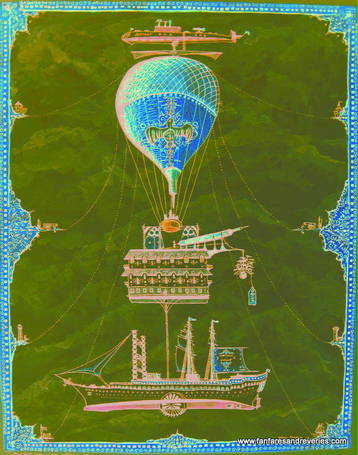 Pen & ink w/watercolor, 11" x 14", G. Tompkins Pen & ink w/watercolor, 11" x 14", G. Tompkins Further Drama, Adventure & Scenes As the island dwellers climb to the top of a steep and active volcano, they observe a small boat just off shore far in the distance. Clambering back to the sandy beach in hopes of making contact, the group discovers two surviving ladies and one dead seaman washed ashore. Bernard Herrmann's music is tender and compassionate at the discovery of these two lone survivors of an apparent shipwreck off shore. Herrmann once described a film's soundtrack music as "the connecting link between celluloid and audience, reaching out and enveloping all into one single experience." Mysterious Island features one of Herrmann's best scores, also available separately via a Tribute Film Classics CD with William Stromberg conducting the Moscow Symphony Orchestra. The score restoration is by John Morgan, Anna Bonn, and William Stromberg, available from screenarchives.com. The music is fabulous, with wide range high fidelity sound and tremendous scope and symphonic power. In 1975 the Decca Record Company issued a classic LP entitled "The Mysterious Film World of Bernard Herrmann," featuring Herrmann conducting the National Philharmonic Orchestra on a London Phase 4 Stereo disc, recorded at Kingsway Hall in London. Besides several selections from "Mysterious Island," this LP also includes music from Herrmann's scores for "Jason & The Argonauts" and "The Three Worlds of Gulliver." Interesting Characters & Fascinating Dimensions Actress Joan Greenwood (1921-1987) plays Lady Mary Fairchild with her regal accent and noble bearing. Born in Chelsea, Joan Greenwood studied at the Royal Academy of Dramatic Art and appeared in films such as "Kind Hearts & Coronets" (1949) and "The Importance of Being Earnest" (1952). She enjoyed a stage career appearing with Donald Wolfit's theatre company in the years following WWII. In her role as Lady Mary in "Mysterious Island," Ms. Greenwood is simply sensational, adding dramatic delight and superlative character to her portrayal of a shipwrecked survivor now stranded upon an uncharted but enchanted island in the Pacific. After the two surviving ladies are discovered on the beach, Herbert relates to Lady Mary that "We came by balloon," to which she immediately responds, "I beg your pardon....Please don't talk nonsense!" Obviously it is an incredible claim by the escaped prisoner of war, but Capt. Harding assures Lady Mary that it is indeed a true if somewhat incredulous story of their flight via a hot air balloon over the Pacific waters. Both Lady Mary and her niece Elena Fairchild (played by actress Beth Rogan) add beauty and grace to this tropical paradise amidst a splendid series of fantastic adventures. Details Along the Journey The film continues with brief portraits of forests and woods. Several scenes feature a sensational portrait of caves which Capt. Harding climbs via long lengths of hanging vines in order to inspect the interior. As the Captain enters the caves high above the sandy beach, Bernard Herrmann's music again helps to fashion the atmosphere and drama of the scenes inside the cave. The Captain finds a letter dated 1862 from a dusty diary hidden within the confines of the secretive cave. After determining that the cave would make a suitable home for the island survivors, Capt. Harding orders the rest of the crew to ascend the vines in order to fully inspect the entirety of the cave's interior. In the film's narrative voice-over, the Captain relates that their newly found home was christened "The Granite House," now accessible via a homemade elevator, adding that, "We lived like primitive men." As the group becomes comfortable in their lofty aerie, the conversation between Mr. Spilitt and Lady Mary enters a delightful phase as Mr. Spilitt turns toward the elegant Lady, eloquently stating the observation that, "At the moment my main comfort is your presence." Mr. Spilitt pretends to use opera glasses as he takes a momentary break from shaving in this inventive, imaginative and thoroughly captivating scene. 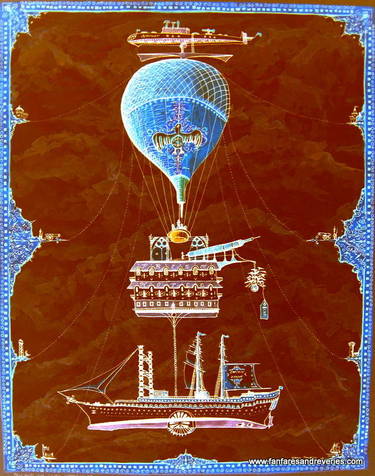 Pen & ink w/watercolor, 11" x 14", G. Tompkins Pen & ink w/watercolor, 11" x 14", G. Tompkins Dramatic Events & Exotic Atmosphere During the storm sequence over the Pacific Ocean, the rapidly descending balloon is pushed further westward toward an unknown island. We catch a brief glimpse of some rocks in the distance as one of the crew announces the sound of waves crashing against the shore. The group remains in a precarious position above the churning waters below, as rain continues to lash the balloon amid furious winds and the threat of impending disaster. Capt. Harding falls from the rigging and hits the water, followed by Herbert and then Mr. Spilitt who says he will swim all the way to shore. Neb and Sgt. Pencroft are the only two left holding onto the balloon's rigging as they are finally dragged up onto the sandy beach. The following scene opens upon a magnificent beach as the survivors begin to search for Capt. Harding. The matte painting is sensational in this beautiful portrait of a tropical island, with fluttering seagulls waving about and huge volcanic mountains in the distance. The atmospheric flavor breathes with incredible color, splendid detail and verdant tropical majesty. Full credit for the masterfully created scenes in this film would have to include William C. Andrews (Art Direction), Francisco Prosper (Construction Coordinator, Art Department, uncredited), Ray Harryhausen (Creator of Visual Effects), Vic Margutti (Special Photographic Effects, uncredited), Wilkie Cooper (Cinematography), Cy Endfield (Director), Charles H. Schneer (Producer), and Bernard Herrmann (Music, with the London Symphony Orchestra). Making a Home on the Island & Exploration of the Landscape In order to restore stamina for the crew after finding Capt. Harding, Mr. Spilitt cooks up a batch of giant oyster stew "seasoned with seaweed." There is some speculation amongst the survivors as to their exact location, perhaps Figi or New Zealand. Capt. Harding narrates the evolving story via his detailed observations delivered through the accompanying voice-over. "The landscape everywhere was a mixture of the strange and the beautiful." Volcanoes stand surrounded by tropical palm trees and sandy beaches, all of it "a riot of wonderful hues and fantastic colors." The Captain relates that there is "no evidence that man had ever set foot here before." Towards an exploration of the interior of the island, a stream and a magnificent waterfall appear in the midst of a lush tropical forest, again the results of spectacular matte painting. The survivors manage to battle a giant crab and win the fight when the creature falls into a hot geyser along the beach. We catch glimpses of a realistic volcano in the distance, which Capt. Harding orders the crew to scale in order to better observe their present location. In managing to climb to the summit of the volcano, Mr. Spilitt finds a pleasant surprise. "Giant mice!" he exclaims upon finding a herd of wild goats, all of which are dutifully pressed into service. Looking into the mouth of the volcano, one can perfectly visualize both the splendor and the terror of this genuinely awe-inspiring phenomenon.  Arizona often imitates an exotic scene from Mysterious Island. Arizona often imitates an exotic scene from Mysterious Island. A Memorable Fantasy Film in the Science Fiction Genre Cy Endfield directed "Mysterious Island" with a screenplay written by John Prebble, Daniel Ullman and Crane Wilbur, loosely based upon the original novel by French author Jules Verne (1828-1905). The cast is comprised of Michael Craig as Capt. Cyrus Harding, Joan Greenwood as Lady Mary Fairchild, Michael Callan as Herbert Brown, Gary Merrill as Gideon Spilitt, Herbert Lom as Capt. Nemo, Beth Rogan as Elena Fairchild, Percy Herbert as Sgt. Pencroft, and Dan Jackson as Cpl. Neb Nugent. The film was produced by Charles H. Schneer, featuring a grand music score by Bernard Herrmann (recorded with the London Symphony Orchestra), cinematography by Wilkie Cooper, Art Direction by Bill Andrews, and sensational visual effects created by Ray Harryhausen. Opening Credits and Following Scenes The film opens with the powerful orchestral music of Bernard Herrmann, utilizing a very large orchestra incorporating 8 horns, 4 tubas and an expanded wind and percussion section. We are swept up into enormous waves of imagination as we encounter Herrmann's vivid and spectacular score. Although Ray Harryhausen has stated that his original idea was to showcase a prehistoric concept, he indicates in the accompanying documentary that this plan was altered in order to highlight the plight of survivors on a marooned island in the Pacific, a vehicle for introducing giant creatures via the "Super Dynamation" process. The film opens with a scene from the American Civil War as Federal and Confederate armies face one another during the Siege of Richmond, Virginia in 1865. As a storm rages outside of a Confederate prison, Federal prisoners make plans to escape, hoping to capture an observation balloon despite an armed guard and the furious windstorm aloft. The masterful set design gives a very atmospheric feel to the interior of the prison and the outer courtyard where the balloon is secured in the midst of buffeting winds and heavy rainfall. Through a clever execution of events, the Federal prisoners make their daring escape and manage to take the balloon aloft, narrowly missing a few rifle shots from the Confederate guards as well as avoiding a sharp steeple almost directly in their appointed path of ascent. The Journey Aloft Although Capt. Harding's plan of escape is successful, the group of escapees now includes a Confederate soldier (Sgt. Pencroft) who valiantly attempts but fails to halt the stealing of the balloon. Now there are five passengers in the wicker basket beneath the balloon, including Capt. Harding, Pvt. Herbert Brown, newspaper correspondent Gideon Spilitt, Cpl. Neb Nugent and the aforementioned Sgt. Pencroft (an unwilling participant in the grand escape). As furious winds carry the balloon further and further aloft, Capt. Harding narrates the story via a descriptive voice-over, indicating they are now "prisoners of the wind" in the greatest storm in American history. The group witnesses "forests torn up by their roots," and begins to feel "helpless in the storm's mighty grip." Capt. Harding intuitively speculates internally about ever setting foot on earth again. Music, Storms & Atmosphere When someone notices a large body of water below, the group decides to lower the balloon's altitude in order to investigate their exact location. After days of travel initiated by incredible winds, it is thought that they may now be over the Pacific Ocean. As the descent proves to be too fast (due to a stuck release valve), Capt. Harding heroically climbs up the craft's rigging to try to stem the rapid fall but manages only to break the valve. The group is now stuck in mid-air, unable to descend or ascend, frozen at a specific height above the ocean waters below. A storm appears, forcing the crippled vessel to be carried westward in the furious current of the moment, lashed by wind-gusts and torrential patterns of rain. The balloon tears open causing a rapid descent toward the angry waters swirling beneath the imperiled craft. Capt. Harding orders everything of weight to be thrown out, guns, food, ammunition, all in order to reduce heaviness. Everyone must climb the rigging to get closer to the balloon in hopes of jettisoning the wicker basket as a further measure of weight reduction. It is a precarious moment and Herbert hesitates as he looks down upon the violently churning sea far below. Capt. Harding orders Herbert to make a snap decision, "You climb or you drown!" This scene features a magnificent portrait of the sea and the ruptured balloon as the basket is cut loose and falls to earth below. The music of Bernard Herrmann adds immensely to the overall excitement, flavor and atmosphere of the special effects introduced by Ray Harryhausen and the artists involved in this thrilling fantasy film. |
Author
|
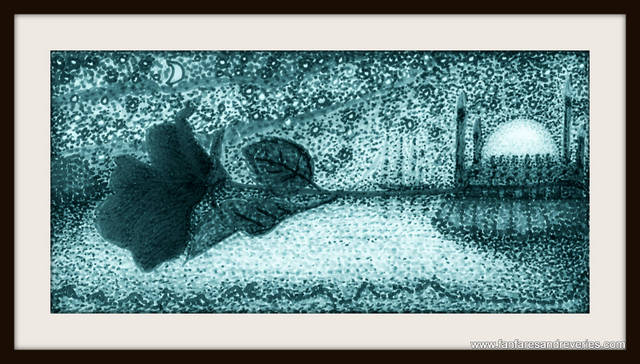

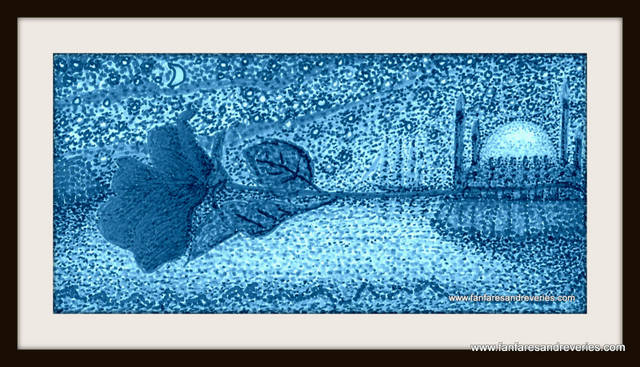


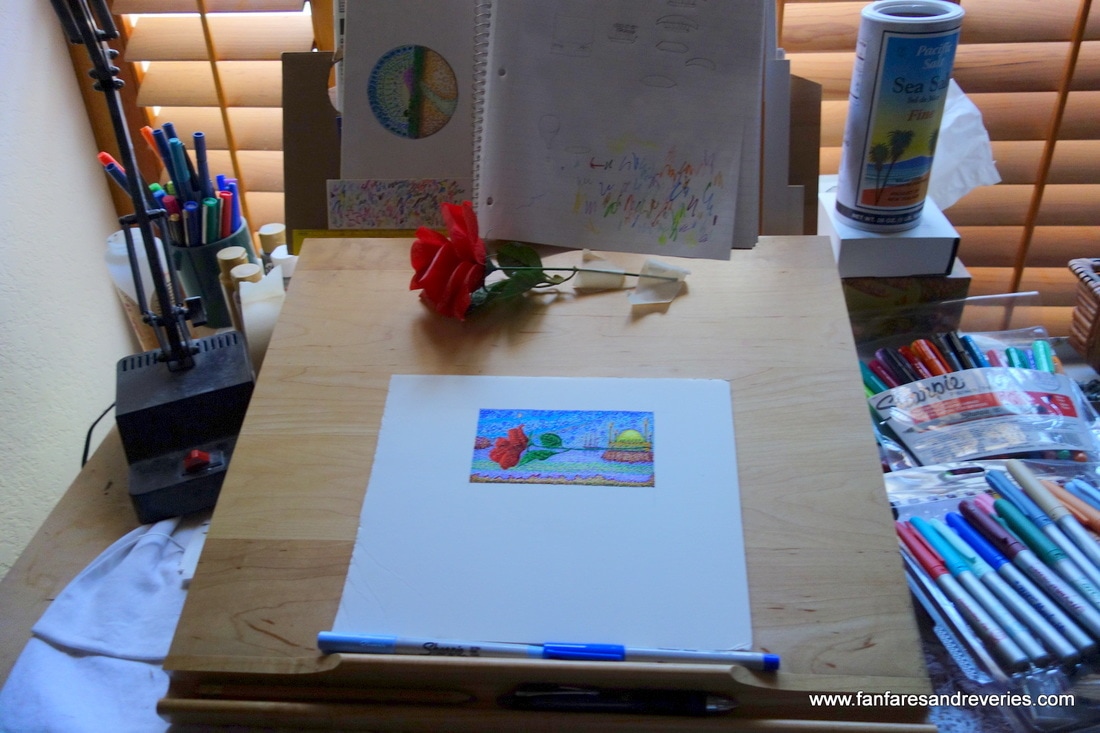
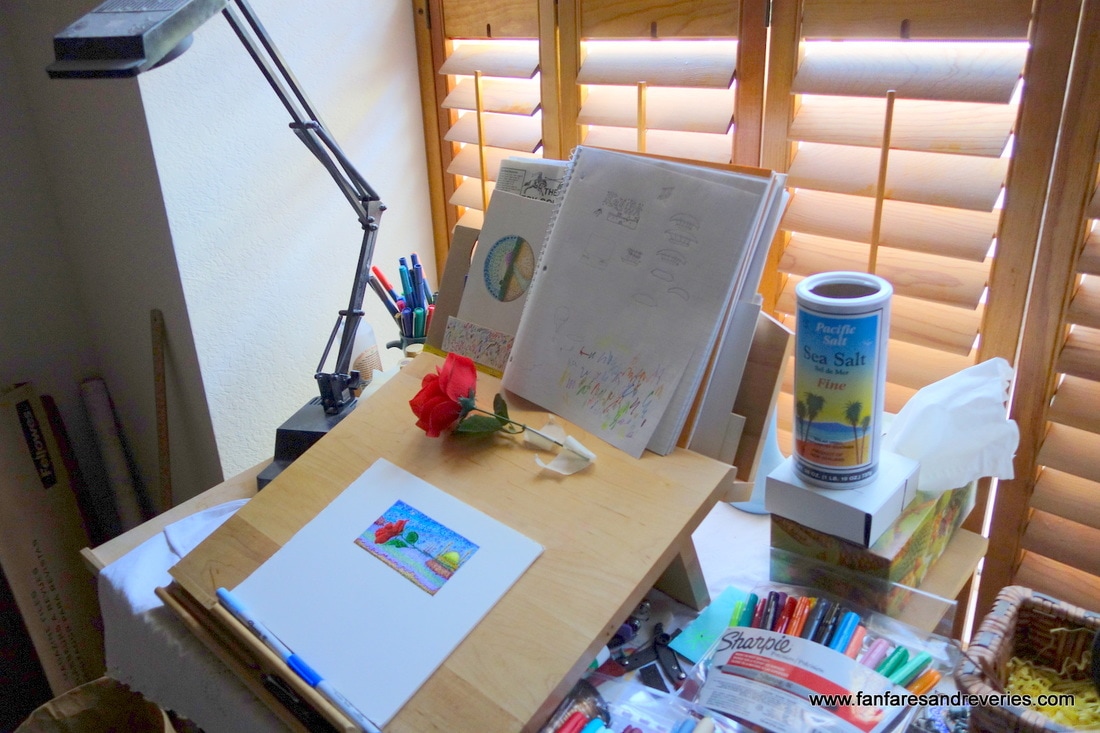
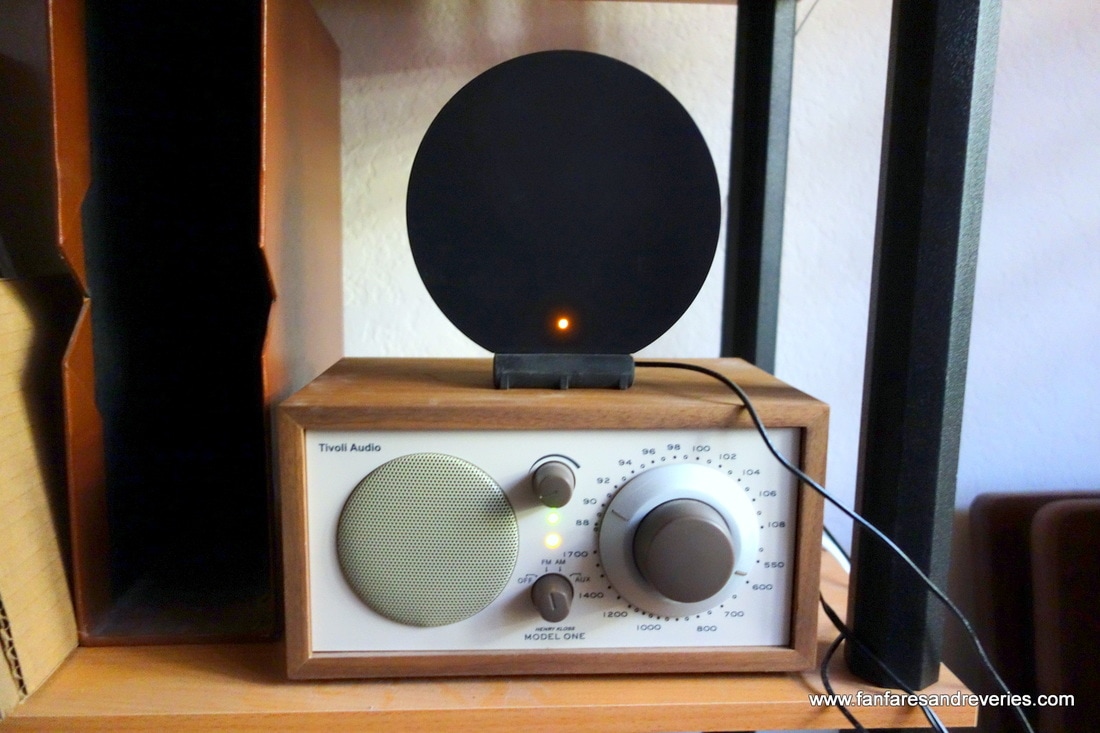
 RSS Feed
RSS Feed